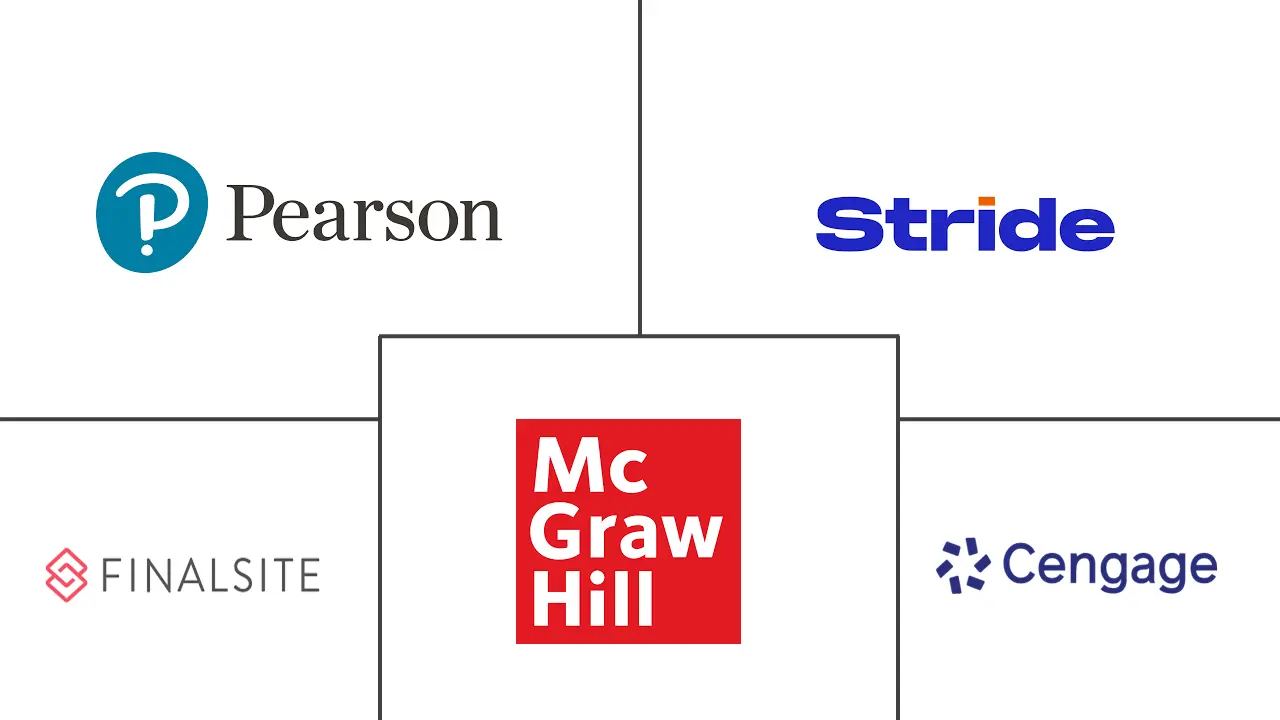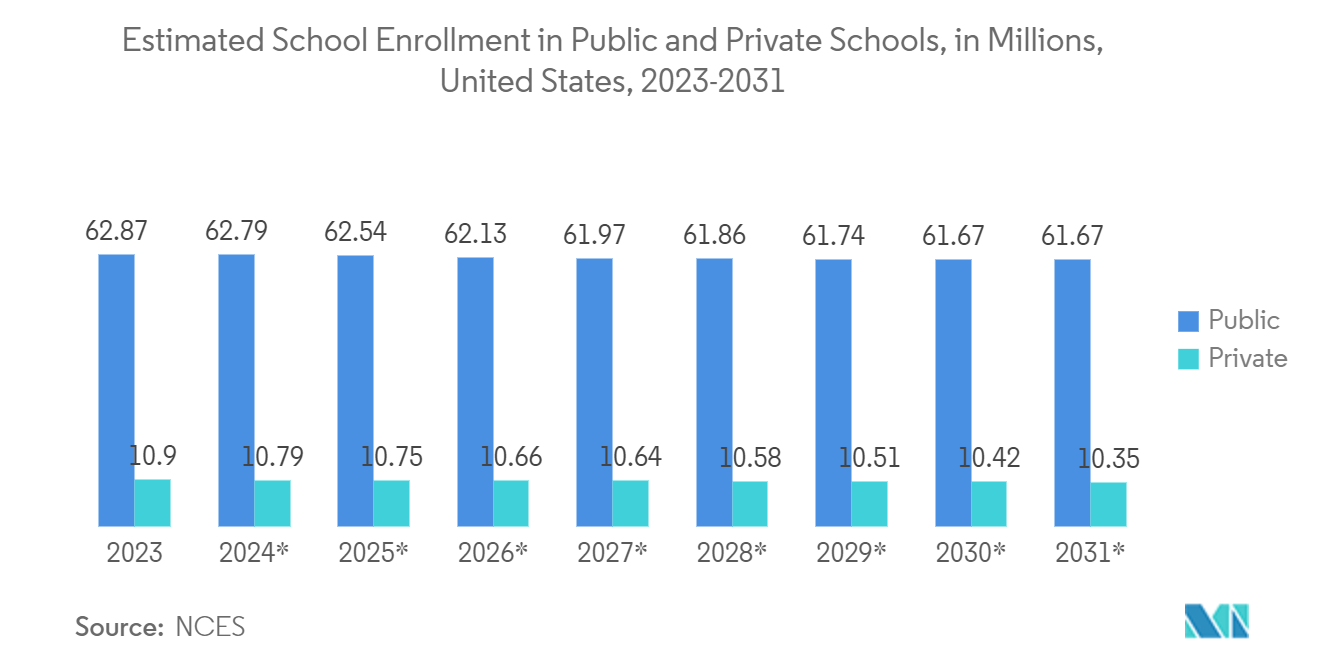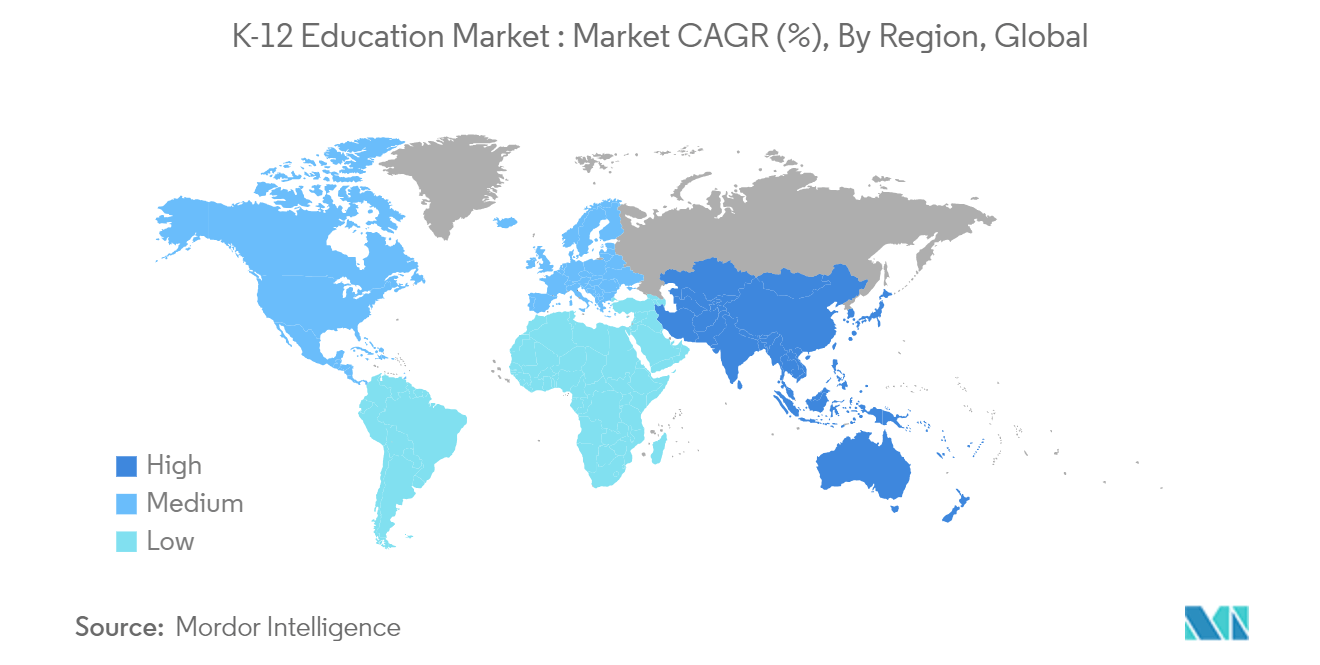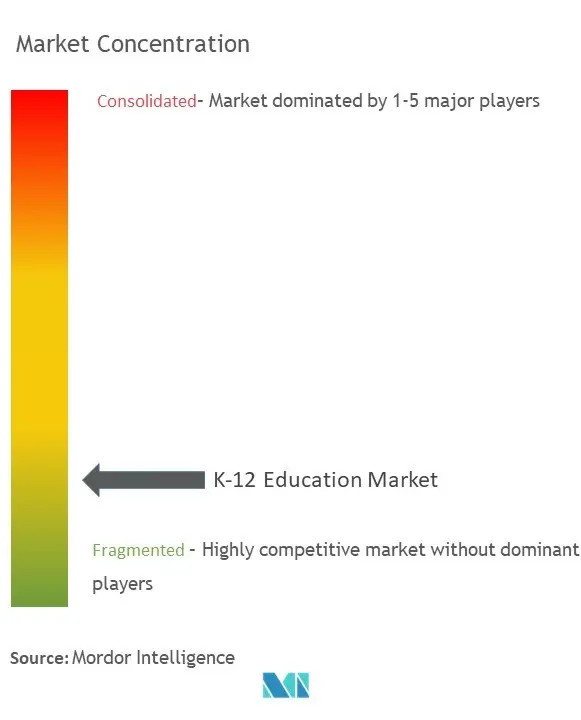K-12 Education Market Size

| Study Period | 2019 - 2029 |
| Market Size (2024) | USD 4.23 Billion |
| Market Size (2029) | USD 6.98 Billion |
| CAGR (2024 - 2029) | 10.09 % |
| Fastest Growing Market | Asia Pacific |
| Largest Market | Asia-Pacific |
Major Players
*Disclaimer: Major Players sorted in no particular order |
K-12 Education Market Analysis
The K-12 Education Market size is estimated at USD 4.23 billion in 2024, and is expected to reach USD 6.98 billion by 2029, growing at a CAGR of 10.09% during the forecast period (2024-2029).
The K-12 education market analyzes digital learning platforms and services (e-learning and learning management services) across K-12 for students and instructors. The study tracks the demand for the K-12-based education technology market based on the contribution of platform solutions and services offered by vendors worldwide.
- The increasing popularity of online education due to its benefits, such as giving students more valuable and video-based content for a better understanding of the subjects in K-12 schools, is driving the market growth of digital learning solutions worldwide. For instance, in September 2023, Adobe, the American multinational computer software company, partnered with India's Ministry of Education to provide schools with Adobe Express-based curriculum, training, and certification. The initiative plans to cover 20 million students and 500,000 educators across India by 2027, showing the increasing adoption of software tool-based education in K-12 institutions. Such developments are expected to drive the growth of the market studied.
- The popularity of online learning has seen substantial growth during and after the COVID-19 pandemic, largely governed by the growth in a number of online learning platforms, coupled with benefits such as accessibility, flexibility, and affordability.
- In addition, the rise of online education in the K-12 sector has revolutionized the education sector, leading to the emergence of new online learning platforms and delivery methods. The growth in internet penetration and smartphone penetration has emerged as a driver for the growing popularity of online learning in K-12 schools.
- Online education can also provide students with more opportunities. This includes allowing them to study at an international institution without having to travel or move abroad. This method of learning is also more cost-effective because it cuts out the need for the student to travel to attend classes or, in some cases, the need to purchase textbooks.
- However, the lack of digital infrastructures, the presence of digital divides, and the unavailability of supporting internet infrastructure in many rural and sub-urban parts of the world, especially in underdeveloped and developing economies, are restricting the growth of e-learning, hampering the growth of the K-12 education market.
K-12 Education Market Trends
Public K-12 Education Segment to Witness Major Growth
- There has been widespread adoption of learning management systems in public schools, and countries worldwide are adopting e-learning in public K-12 education to create a digital education framework, driving the growth of the education market in K-12 public schools.
- The market has been seeing collaboration among the market vendors to increase their capabilities and support market growth. For instance, in October 2023, Open LMS, a provider of open-source learning management systems (LMS) in the United States, partnered with Blindside Networks, the creators of BigBlueButton, a purpose-built virtual classroom software that focuses on learning outcomes. This partnership would enable Open LMS to offer an education-first virtual classroom for government K-12 education institutions, showing the demand for LMS solutions in public schools. This is expected to fuel the K-12 Education Market during the forecast period.
- Further, public schools in developed countries such as the United States are offering training on digital literacy for students and offering the infrastructure needed for online learning, which could positively impact the growth of the K-12 education market. For instance, according to the survey results released by the United States Department of Education’s National Center for Education Statistics (NCES), there are far more public school students than private school students in the United States. By 2031, it is estimated that about 10.3 million students will be enrolled in private schools in the United States. This figure will stand close to 61.67 million for public school students.
- Therefore, the increasing investments and priority by the governments of various countries to support digitalization adoption in public K-12 schools for better management of the learning process are expected to fuel the market growth of K-12 education worldwide in public schools during the forecast period.

Asia-Pacific to Hold Significant Market Share
- The demand for K-12 education in the Asia-Pacific region has experienced remarkable growth, propelled by various factors highlighting the significance of quality education in developing nations. Several key trends contribute to the increasing demand for K-12 education across Asia-Pacific.
- South and Southeast Asia represent one-third of the world's population, with rapidly growing economies and populations. Densely populated and with a younger average age than many developed nations, the opportunity to bring a digital education transformation to these dynamic populations can create a broad impact and improve the educational experience and livelihoods of millions.
- Asia-Pacific countries are integrating education technologies into their education systems. Due to this, a growing demand for schools leveraging technology to enhance learning experiences has been seen. Online platforms, interactive content, and digital tools are becoming integral components of modern K-12 education in the region.
- For instance, in May 2023, TAL Education Group, a Chinese education company and provider of after-school education and tutoring services for students, announced that the company is creating MathGPT, a large-scale mathematical model. This model is intended for math aficionados and research institutes, with problem-solving and teaching algorithms at its core.
- With increased globalization, there is a growing interest in providing students with a global perspective. International schools that offer a curriculum that combines local and global elements are gaining popularity. Parents seek schools that prepare their children to thrive in a diverse and interconnected world.
- Hence, the growing demand for K-12 education in the Asia-Pacific region is driven by demographic shifts, economic development, technological advancements, a focus on English proficiency, globalization trends, government initiatives, and the pursuit of high-quality education. This demand will continue evolving as the region positions itself as a key player in the global education landscape.

K-12 Education Industry Overview
The K-12 education market is fragmented in nature as there are many companies competing for market share. Major players include McGraw-Hill Education (Platinum Equity), Pearson Education Inc., Stride Inc. (K12 Inc.), Cengage Learning India Pvt. Ltd, Finalsite, and others.
- July 2023 - VUS, an education center in Vietnam, partnered with global education company McGraw Hill to introduce a Critical Math program based on McGraw Hill’s Reveal Math, a leading K–12 math program, to pre-primary and primary children in Vietnam.
- June 2023 - Pearson, a learning company, announced that Connections Academy, its K-12 online school program, will expand its slate of college and career readiness initiatives for middle and high school students. The initiatives include partnerships with Coursera, an online learning platform; Acadeum, a course-sharing network in higher education; eDynamic Learning, a provider of career technical education for middle and high school students; and Credly, a global provider of digital credentialing.
K-12 Education Market Leaders
-
McGraw-Hill Education (Platinum Equity)
-
Pearson Education Inc.
-
Cengage Learning India Pvt. Ltd
-
Stride Inc. (K12 Inc.)
-
Finalsite
*Disclaimer: Major Players sorted in no particular order

K-12 Education Market News
- August 2023 - PowerSchool announced the launch of its learning management system (LMS), Schoology Learning, in the Indian market. Schoology Learning equips K-12 schools with a complete set of tools to boost student performance and empower educators. The solution offers video conferencing and integrated assessment management to improve student performance, foster collaboration, and personalize learning.
- June 2023 - Tata ClassEdge Limited introduced its next-generation digital classroom solution, ClassEdge Platinum (CE Platinum). ClassEdge Platinum is an industry-first, immersive, and collaborative digital classroom platform that allows teachers to build learning experiences for students with the best of technology, content, and pedagogy.
K-12 Education Market Report - Table of Contents
1. INTRODUCTION
- 1.1 Study Assumptions and Market Definition
- 1.2 Scope of the Study
2. RESEARCH METHODOLOGY
3. EXECUTIVE SUMMARY
4. MARKET INSIGHTS
- 4.1 Market Overview
-
4.2 Industry Attractiveness - Porter's Five Forces Analysis
- 4.2.1 Bargaining Power of Suppliers
- 4.2.2 Bargaining Power of Buyers
- 4.2.3 Threat of New Entrants
- 4.2.4 Threat of Substitutes
- 4.2.5 Intensity of Competitive Rivalry
- 4.3 Impact of COVID-19 on the Market
5. MARKET DYNAMICS
-
5.1 Market Drivers
- 5.1.1 Growing Popularity of Online Learning
-
5.2 Market Restraints
- 5.2.1 Lack of Infrastructure and Limited Awareness of E-learning
-
5.3 E-book Insights vis-a-vis K-12 Online Education
- 5.3.1 Utility of Digital Content for Classroom Instruction (Digital Content vs. Print Material)
- 5.3.2 K-12 Digital Content Trends and Related Survey Insights
- 5.3.3 Indicative Market Share (%) of E-textbooks in the E-books Industry
6. MARKET SEGMENTATION
-
6.1 By Type
- 6.1.1 Public K-12 Education
- 6.1.2 Private K-12 Education
-
6.2 By Application
- 6.2.1 Pre-primary School and Primary School
- 6.2.2 Middle School
- 6.2.3 High School
-
6.3 By Geography***
- 6.3.1 North America
- 6.3.2 Europe
- 6.3.3 Asia
- 6.3.4 Australia and New Zealand
- 6.3.5 Latin America
- 6.3.6 Middle East and Africa
7. COUNTRY ANALYSIS AND INSIGHTS
-
7.1 United States
- 7.1.1 Market Estimates and Forecasts on K-12 Education, 2021-2028
- 7.1.2 Segment Analysis - United States
- 7.1.2.1 By Type (Public and Private)
- 7.1.2.2 By Technology (E-learning and LMS)
- 7.1.2.3 By Application (Pre-primary and Primary Schools, Middle School, and High School)
-
7.2 United Kingdom
- 7.2.1 Market Estimates and Forecasts on K-12 Education, 2021-2028
- 7.2.2 Segment Analysis - United Kingdom
- 7.2.2.1 By Type (Public and Private)
- 7.2.2.2 By Technology (E-learning and LMS)
- 7.2.2.3 By Application (Pre-primary and Primary Schools, Middle School, and High School)
-
7.3 Germany
- 7.3.1 Market Estimates and Forecasts on K-12 Education, 2021-2028
- 7.3.2 Segment Analysis - Germany
- 7.3.2.1 By Type (Public and Private)
- 7.3.2.2 By Technology (E-learning and LMS)
- 7.3.2.3 By Application (Pre-primary and Primary Schools, Middle School, and High School)
-
7.4 France
- 7.4.1 Market Estimates and Forecasts on K-12 Education, 2021-2028
- 7.4.2 Segment Analysis - France
- 7.4.2.1 By Type (Public and Private)
- 7.4.2.2 By Technology (E-learning and LMS)
- 7.4.2.3 By Application (Pre-primary and Primary Schools, Middle School, and High School)
-
7.5 Japan
- 7.5.1 Market Estimates and Forecasts on K-12 Education, 2021-2028
- 7.5.2 Segment Analysis - Japan
- 7.5.2.1 By Type (Public and Private)
- 7.5.2.2 By Technology (E-learning and LMS)
- 7.5.2.3 By Application (Pre-primary and Primary Schools, Middle School, and High School)
8. COMPETITIVE LANDSCAPE
-
8.1 Company Profiles*
- 8.1.1 McGraw-Hill Education (Platinum Equity)
- 8.1.2 Pearson Education Inc.
- 8.1.3 Cengage Learning India Pvt. Ltd
- 8.1.4 Stride Inc. (K12 Inc.)
- 8.1.5 Finalsite
- 8.1.6 Tata ClassEdge
- 8.1.7 Next Education India Pvt. Ltd
- 8.1.8 ALMA
- 8.1.9 TAL Education Group
- 8.1.10 Think and Learn Private Limited (BYJU'S)
- 8.1.11 Desmos Studio PBC
- 8.1.12 Bettermarks GmbH
- 8.1.13 Mooka Media Ltd
- 8.1.14 Instructure Inc. (Thoma Bravo)
- 8.1.15 Clever Inc. (Kahoot)
9. INVESTMENT ANALYSIS
10. FUTURE OF THE MARKET
** Subject To AvailablityK-12 Education Industry Segmentation
K-12, a term used in education and educational technology in the United States, Canada, and some other countries, is a short form for the publicly supported school grades prior to college.
The K-12 education market is segmented by type (public K-12 education and private K-12 education), application (pre-primary school and primary school, middle school, and high school), and geography (North America, Europe, Asia-Pacific, Latin America, and Middle East and Africa). The market sizes and forecasts are provided in terms of value (USD) for all the above segments.
| By Type | Public K-12 Education |
| Private K-12 Education | |
| By Application | Pre-primary School and Primary School |
| Middle School | |
| High School | |
| By Geography*** | North America |
| Europe | |
| Asia | |
| Australia and New Zealand | |
| Latin America | |
| Middle East and Africa |
K-12 Education Market Research FAQs
How big is the K-12 Education Market?
The K-12 Education Market size is expected to reach USD 4.23 billion in 2024 and grow at a CAGR of 10.09% to reach USD 6.98 billion by 2029.
What is the current K-12 Education Market size?
In 2024, the K-12 Education Market size is expected to reach USD 4.23 billion.
Who are the key players in K-12 Education Market?
McGraw-Hill Education (Platinum Equity), Pearson Education Inc., Cengage Learning India Pvt. Ltd, Stride Inc. (K12 Inc.) and Finalsite are the major companies operating in the K-12 Education Market.
Which is the fastest growing region in K-12 Education Market?
Asia Pacific is estimated to grow at the highest CAGR over the forecast period (2024-2029).
Which region has the biggest share in K-12 Education Market?
In 2024, the Asia-Pacific accounts for the largest market share in K-12 Education Market.
What years does this K-12 Education Market cover, and what was the market size in 2023?
In 2023, the K-12 Education Market size was estimated at USD 3.80 billion. The report covers the K-12 Education Market historical market size for years: 2019, 2020, 2021, 2022 and 2023. The report also forecasts the K-12 Education Market size for years: 2024, 2025, 2026, 2027, 2028 and 2029.
What are the key trends influencing the K-12 Education Market?
Major trends in the K-12 Education Market include a) Integration of technology in education b) Personalized learning c) Increase in educational accessibility through digital platforms
K-12 Education Industry Report
The K-12 Education Market is experiencing significant growth, driven by the integration of advanced technologies such as Artificial Intelligence (AI), Augmented Reality (AR)/Virtual Reality (VR), and personalized learning platforms. These innovations are transforming traditional education methods into more interactive and technology-driven models, enhancing student engagement, critical thinking, and mental health support.
Governmental investments are playing a crucial role in improving educational infrastructures, curricula, and teacher training, while also fostering private sector partnerships. This surge in investment presents substantial opportunities for edtech firms, content creators, and educational service providers. The market is characterized by vigorous innovation and mergers as companies strive to meet the evolving educational demands.
Despite the dominance of traditional public and offline education, online learning platforms are gaining traction, offering a personalized and flexible learning experience. The Asia Pacific region is witnessing rapid growth, fueled by increased internet access and government educational reforms. The emphasis on STEM and early education highlights the K-12 sector as a critical investment area.
The market size and market trends indicate a robust expansion, with a detailed market forecast predicting continued market growth. The global market overview reveals that the largest companies are actively participating in this dynamic environment. Comprehensive market analysis and market research provide valuable insights into market share and industry statistics.
Industry reports and industry research underscore the importance of understanding market data and market segmentation. The industry outlook and market predictions suggest a positive trajectory for the K-12 education sector. Market leaders are setting benchmarks, while the market value reflects the sector's economic significance.
For more detailed industry information, including market review and market overview, industry sales, and industry trends, accessing a report pdf from Mordor Intelligence™ Industry Reports can provide further clarity. This report example offers a thorough examination of the market dynamics, making it an essential resource for stakeholders looking to navigate the K-12 education market.



